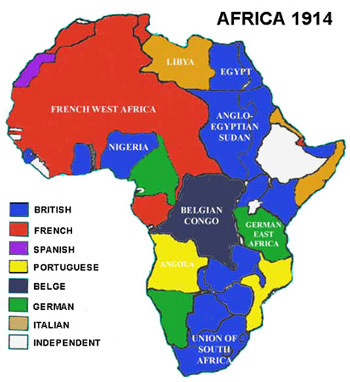By the second half of the nineteenth century, European states (and the United States) had grown more powerful militarily, economically and technologically than societies and countries in much of the rest of the world. This set the stage for a renewed effort to expand and establish European (and American) influence and control over territories in Australia, Africa, Asia and the Pacific Rim. That effort soon turned, quite literally, into a mad scramble to extend national power and prestige overseas, "to plant the flag around the world." In Africa, the race was on to carve up Africa into European-controlled spheres-of-influence. This imperialist competition helped to increase tensions among countries in Europe and was one of the contributing factors leading to World War I.
The imperialist race also fit with social Darwinist thought that was widespread at the time. Roughly speaking, these social Darwinist proponents argued that it was a struggle to survive amongst the peoples of the world, that the fittest would survive. Thus, a country had to fight to control as much of the world as possible to ensure its future. One aspect of the imperialist mission was for the more civilized to civilize the less civilized. That meant that Europeans were charged with bringing civilization to much of Africa, for example. It was the destiny of European countries to control the world and bring the fruits of civilization to the lower peoples of the world.
It is an oft-forgotten fact that the United States also erected its own overseas empire by the turn of the twentieth century. As a direct result of the Spanish-American War, the U.S. obtained, for all practical purposes, Cuba and the Philippines as colonial possessions. Islands in the Caribbean and the Pacific, such as Hawaii, also came under American control. There was also the American economic empire in Central America, carved out by powerful U.S. business concerns that practically functioned with behind-the-scenes dictatorial control. Thus, America was as much a participant in the race for empire as the European states.
Beginning in the nineteenth century, the non-European world began to experience the direct impact of European military, economic and intellectual power. This was something that much of the world had been able to avoid for a long period of time, but no longer. In most cases the superior technological advances (weaponry) of Europe and North America confronted Asian and African societies with a direct challenge to their existence. The responses of these societies varied dramatically, from the decision to copy the West's economic characteristics as much as practicable (Japan after the Meiji Restoration 1868) to the decision to undertake radical political revolution based on a Western model (The Xinhai Revolution in China in 1911) to outright subservience (Belgian Congo in 1908). Increasingly, the Western economic model (capitalism and heavy industrial development) and the Western political structure (the idea of the national state) became a model to be adapted (and modified) throughout the world. This had a dramatic impact on the integrity of native societies.
![]()
Some recommended online lectures and websites
- Kevin Gaskin (former student), The Boer Wars, a timeline covering 1877 to 1900
- At Boundless World History, see the section on The Scramble for Africa (Reasonably well done).
- The Scramble for Africa (Wikipedia entry also)
- Wikibooks: World History/Ancient Civilizations (The Age of Imperialism, Part II)
- A great site on the Boer War created by Soria Darwish, former student
- Ehiedu E. G. Iweriebor, The Colonization of Africa
- Colonialism and imperialism (Wikipedia entries)
- Timeline by Ashlei Sutton, student, on the Major Events of the Anglo-Zulu War
- The Dark Continent Partitioned by Charles Kimball
- For extra credit please suggest to your instructor a relevant website for this unit of the course. Send the title of the site, the URL and a brief explanation why you find the information interesting and applicable to the material being studied in this unit.
